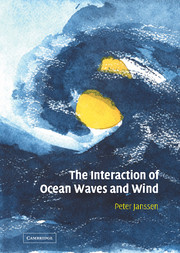5 - Wave forecasting and wind–wave interaction
Published online by Cambridge University Press: 06 October 2009
Summary
This chapter is devoted to a synthesis of what we have previously learned about the physics of wind–wave interaction, culminating in a numerical wave prediction system. After a brief discussion of the numerics of such a model, we illustrate the combined effects of wind input, nonlinear interactions and dissipation on the simple case of the growth of surface gravity waves by wind for an infinite ocean. The resulting growth laws for parameters such as wave height, peak frequency and the Phillips parameter are compared with empirical growth laws. Also, the simulated wave-age dependence of ocean roughness is compared with a number of empirical fits. In addition, we discuss effects of gustiness on wave evolution and roughness of the sea surface which gives an indication of the well-known sensitive dependence of wave results on the forcing wind field.
The resulting wave prediction system turns out to be a promising tool for forecasting purposes and in the remainder of this chapter we discuss a number of applications of the wave forecasting system as it has been implemented at the European Centre for Medium-Range Weather Forecasts (ECMWF). Historically, ECMWF played an important role in the development of the third-generation wave prediction system, called WAveModel (WAM). They provided the necessary infrastructure (such as supercomputers and data-handling facilities), high-quality surface wind fields and support.
- Type
- Chapter
- Information
- The Interaction of Ocean Waves and Wind , pp. 209 - 274Publisher: Cambridge University PressPrint publication year: 2004



